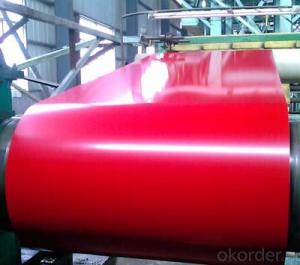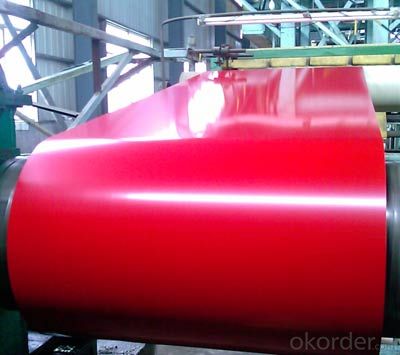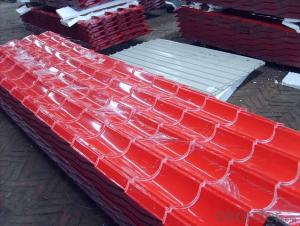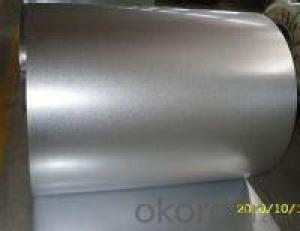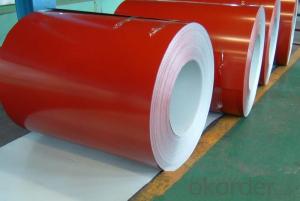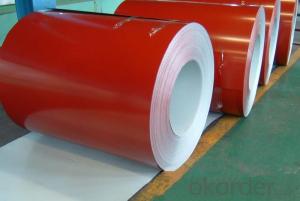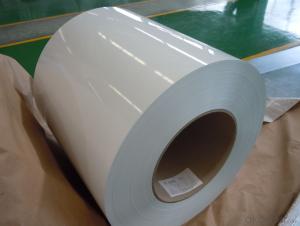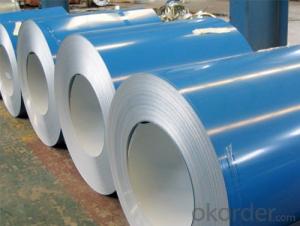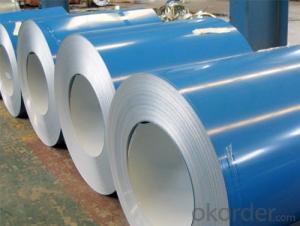Pre-painted Galvanized/Aluzinc Steel Sheet Coil with Prime Quality and Lowest Price RED
- Loading Port:
- Shanghai
- Payment Terms:
- TT OR LC
- Min Order Qty:
- 100 m.t.
- Supply Capability:
- 10000 m.t./month
OKorder Service Pledge
OKorder Financial Service
You Might Also Like
1.Pre-Painted Galvanized/Aluzinc Steel Coil Description:
2.Main Features of the Pre-Painted Galvanized/Aluzinc Steel Coil
• High workability
• Good visual effect
• Good capable of decoration
• Superior strength
3.Detail Images of Pre-Painted Galvanized Steel Coil
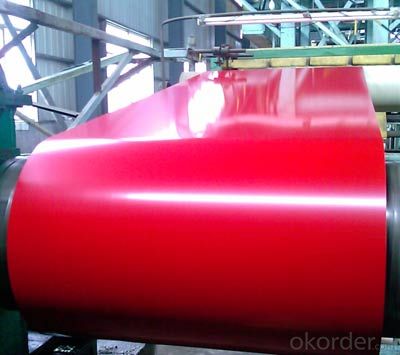
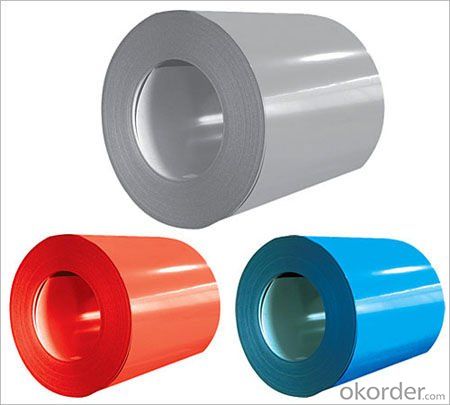
1) AVAILABLE DESIGNATION OF PPGI/PPGL Prepainted Galvanized/Galvalume Steel Coils
Quality | Q/BQB 440-2003 | JIS G3312-1994 | EN 10326-2004 | ASTM A653-02a |
EN 10327-2004 | (BASE PLATE) | |||
(BASE PLATE) | ||||
Commercial Steel | TDC51D | CGCC | DX51D+Z/AZ | CS Type A/B/C |
Forming Steel | (TSt01,TSt02,TSt03) | CGCD1 | FS Type A, Type B | |
Drawing | TDC52D /TDC53D | - | DX52D+Z/AZ | DDS TYPE A/C |
Steel | DX53D+Z/AZ | |||
Structural | TS280GD(TStE28) | CGC400 | S280D+Z/AZ | SS275 |
5.FAQ
2. What’s the brand of the paint?
We use the best brand of all of the word—AKZO.
Pre-painted Galvanized Steel Coil chemical treatment and liquid dope with several layers of colol
- Q: What is stainless steel coil used for?
- Stainless steel coil is primarily used in various industries for its durability, corrosion resistance, and aesthetic appeal. One of the most common applications is in the manufacturing and construction sectors, where stainless steel coils are utilized to produce a wide range of products such as kitchen appliances, cutlery, automotive parts, and architectural structures. The corrosion-resistant properties of stainless steel make it an ideal choice for applications that require resistance to moisture, chemicals, and harsh environmental conditions. Additionally, the high strength and heat resistance of stainless steel coils make them suitable for use in industrial equipment, heat exchangers, and piping systems. Moreover, the aesthetic appeal of stainless steel, with its sleek and modern appearance, is often preferred in the design and production of consumer goods, including furniture, jewelry, and decorative items. Overall, stainless steel coil is a versatile material that finds extensive usage across various industries due to its excellent mechanical properties, resistance to corrosion, and aesthetic versatility.
- Q: How are steel coils used in the production of power transmission towers?
- Steel coils are used in the production of power transmission towers as they provide the necessary strength and durability to support the towers and withstand the transmission lines' weight and environmental conditions. The steel coils are shaped and welded into various sections and components, such as the legs, base plates, and cross arms, which are then assembled to create the tower structure. The coils' high tensile strength ensures the towers can withstand the mechanical stresses and loads imposed by the transmission lines, making them a crucial component in the construction of power transmission towers.
- Q: What are the pros and cons to selecting a graphite shaft sand wedge over steel shaft?
- First question, are you guy or girl? stronger or weaker? Steel shaft gives you consistency over graphite because of the weight. For example, Tiger once used a steel shaft in his driver because steel shaft's weight gives him consistency. Key point is he can handle the weight (110g +). Same with you, steel shaft is preferred as it gives you consistency. It's also heavy enough that you can let the natural weight, aka gravity, to let you hit thru the rough, sand, etc.. key point is if you can handle the weight.
- Q: What are the common handling defects in steel coils?
- There are several common handling defects that can occur in steel coils during transportation and storage. These defects can impact the quality and integrity of the coils, leading to potential issues down the line. Some of the most common handling defects in steel coils include: 1. Edge damage: This occurs when the edges of the coil are bumped or scraped, resulting in dents, scratches, or even tears. Edge damage can weaken the structural integrity of the coil and make it more susceptible to further damage. 2. Core damage: The core of a steel coil is crucial for maintaining its shape and stability. However, mishandling can cause the core to become crushed or deformed, which can lead to coil collapse or distortion. 3. Coil slippage: When coils are not securely strapped or stacked, they can shift or slide during transportation. This can result in coil slippage, leading to misalignment, damage to the outer layers, or even complete coil failure. 4. Abrasion: Steel coils can be subject to abrasion if they come into contact with rough surfaces or other objects during handling. This can cause the protective coating or paint on the coil to wear off, exposing the steel to potential corrosion. 5. Moisture damage: Steel coils are susceptible to moisture damage, especially if they are not properly sealed or protected. Exposure to moisture can lead to rust formation, which can compromise the structural integrity of the coil and affect its overall quality. 6. Overloading: Overloading a truck or storage area with steel coils can cause excessive pressure and stress on the coils, leading to deformation, bending, or even coil collapse. It is crucial to adhere to weight limits and proper stacking procedures to prevent overloading. 7. Improper lifting: When lifting steel coils, it is important to use appropriate lifting equipment and techniques. Failure to do so can result in coil damage, such as distortion or bending, as well as potential injuries to workers. To mitigate these handling defects, it is crucial to follow proper handling and storage procedures for steel coils. This includes using suitable lifting equipment, securing the coils during transportation, avoiding overloading, and ensuring proper protection against moisture and abrasion. Regular inspections and maintenance can also help identify and address any potential defects or issues before they worsen.
- Q: What are the different grades of steel used for coils?
- The different grades of steel used for coils vary depending on the specific requirements and applications. Some common grades include low-carbon steel (e.g., ASTM A36), medium-carbon steel (e.g., ASTM A516), high-strength low-alloy (HSLA) steel (e.g., ASTM A572), and stainless steel (e.g., 304 or 316). Each grade offers distinct properties such as strength, corrosion resistance, and formability, enabling manufacturers to choose the appropriate one based on their needs.
- Q: What are the dimensions of steel coils used in automotive component manufacturing?
- The dimensions of steel coils utilized in the manufacturing of automotive components can differ based on the distinct specifications of each component. Nevertheless, the industry typically adheres to standard dimensions, which usually span from 0.5 to 3 millimeters in thickness and 600 to 2,000 millimeters in width. The weight of these coils may vary, but typically falls within the range of 2 to 25 metric tons. These dimensions are carefully selected to ensure hassle-free processing and conversion of the coils into the essential automotive components, while simultaneously meeting the necessary standards for strength and durability, which are essential for their use in vehicles.
- Q: What are the common quality issues with steel coils?
- Some common quality issues with steel coils include: 1. Surface defects: Steel coils may have surface defects such as scratches, pits, or rust spots. These defects can affect the appearance and smoothness of the final product and may also impact its performance. 2. Dimensional variations: Steel coils may exhibit dimensional variations, such as thickness variations, width variations, or length variations. These variations can lead to difficulties in processing the steel and may result in inconsistent product dimensions. 3. Mechanical properties: Steel coils may have variations in mechanical properties such as yield strength, tensile strength, or hardness. These variations can affect the strength and durability of the final product and may also impact its suitability for specific applications. 4. Coating issues: Steel coils that are coated or galvanized may experience issues with the coating, such as uneven coverage, peeling, or adhesion problems. These coating issues can result in reduced corrosion resistance and compromised aesthetics. 5. Internal defects: Steel coils may have internal defects such as inclusions, voids, or segregations. These defects can weaken the steel and may lead to failure or breakage during processing or use. 6. Edge issues: Steel coils may have edge defects, such as burrs, cracks, or uneven edges. These edge issues can affect the handling and processing of the steel and may also lead to problems during fabrication or assembly. 7. Coil set or camber: Steel coils may exhibit coil set or camber, which refers to the curvature or bowing of the coil. This can result in difficulties during processing and may lead to distorted or misaligned products. To ensure the quality of steel coils, manufacturers employ various quality control measures such as rigorous inspection, testing, and adherence to industry standards and specifications.
- Q: What are the different types of steel coil handling attachments?
- Some of the different types of steel coil handling attachments include coil lifters, coil grabs, coil hooks, coil tongs, and coil C-hooks. These attachments are designed to safely lift, transport, and manipulate steel coils of various sizes and weights.
- Q: what is the refining process doing to raw materials in steel
- As Mr. Perfessor says, refining raw steel involves a lot of purifications of the raw steel; and to expand a bit, these refining processes also add corrosion-resistances to certain graded steels, and durability factors, when heat-tempering processes are used. All of these refining processes, and coating processes help steel products last when exposed to moistures, salts, and other corrosive conditions that steel can be exposed to, whether the steel is in open-air/water/space, embedded in concretes and other masonry products, or part of a protective barrier system in power plants, engines, etc. Hope this also helps; the eggster.
- Q: How are steel coils used in the production of industrial shelving?
- Steel coils are used in the production of industrial shelving by being processed and shaped into various components such as shelves, frames, and brackets. These coils are cut, bent, and welded to create sturdy and durable structures that can support heavy loads in industrial settings. The strength and versatility of steel make it an ideal material for manufacturing industrial shelving, ensuring durability and longevity of the shelves.
Send your message to us
Pre-painted Galvanized/Aluzinc Steel Sheet Coil with Prime Quality and Lowest Price RED
- Loading Port:
- Shanghai
- Payment Terms:
- TT OR LC
- Min Order Qty:
- 100 m.t.
- Supply Capability:
- 10000 m.t./month
OKorder Service Pledge
OKorder Financial Service
Similar products
Hot products
Hot Searches
Related keywords
